ignition Alfa Romeo 8C 2009 Owner handbook (in English)
[x] Cancel search | Manufacturer: ALFA ROMEO, Model Year: 2009, Model line: 8C, Model: Alfa Romeo 8C 2009Pages: 223, PDF Size: 14.35 MB
Page 5 of 223
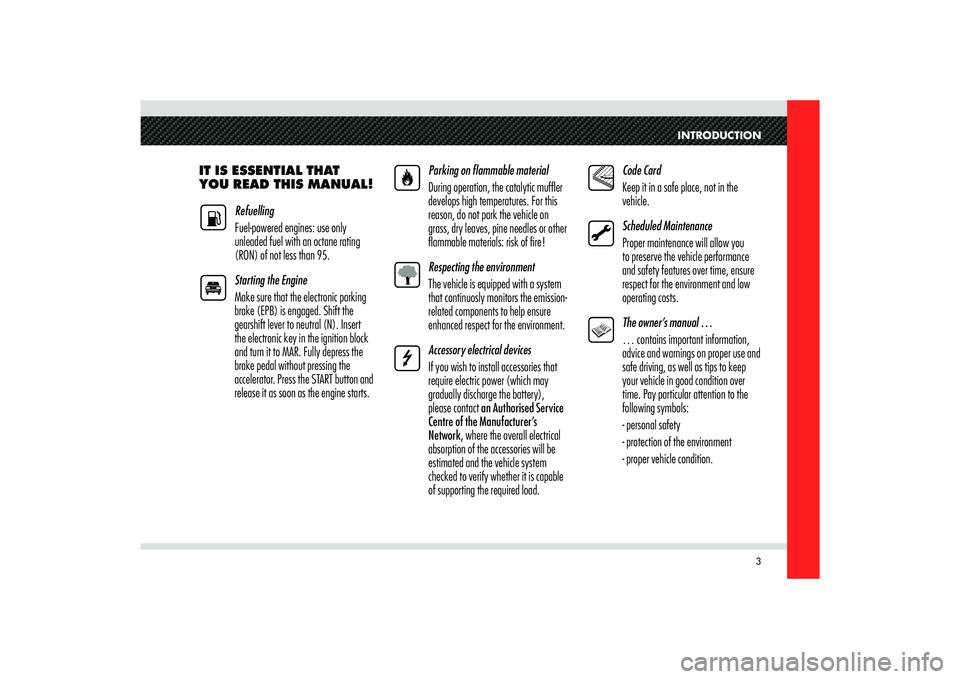
INTRODUCTION
3
IT IS ESSENTIAL THAT
YOU READ THIS MANUAL!
Refuelling
Fuel-powered engines: use only
unleaded fuel with an octane rating
(RON) of not less than 95.
Starting the Engine
Make sure that the electronic parking
brake (EPB) is engaged. Shift the
gearshift lever to neutral (N). Insert
the electronic key in the ignition block
and turn it to MAR. Fully depress the
brake pedal without pressing the
accelerator. Press the START button and
release it as soon as the engine starts.Parking on fl ammable material
During operation, the catalytic muffl er
develops high temperatures. For this
reason, do not park the vehicle on
grass, dry leaves, pine needles or other
fl ammable materials: risk of fi re!
Respecting the environment
The vehicle is equipped with a system
that continuosly monitors the emission-
related components to help ensure
enhanced respect for the environment.
Accessory electrical devices
If you wish to install accessories that
require electric power (which may
gradually discharge the battery),
please contact an Authorised Service
Centre of the Manufacturer’s
Network, where the overall electrical
absorption of the accessories will be
estimated and the vehicle system
checked to verify whether it is capable
of supporting the required load. Code Card
Keep it in a safe place, not in the
vehicle.
Scheduled Maintenance
Proper maintenance will allow you
to preserve the vehicle performance
and safety features over time, ensure
respect for the environment and low
operating costs.
The owner’s manual …
… contains important information,
advice and warnings on proper use and
safe driving, as well as tips to keep
your vehicle in good condition over
time. Pay particular attention to the
following symbols:
- personal safety
- protection of the environment
- proper vehicle condition.
Page 16 of 223

14
1
BA
ELECTRONIC KEYCODE CARD
The car keys are provided with a CODE card,
which contains an electronic code
A, and a
mechanical code
B.
The codes must be kept in a safe place, not in
the vehicle.
WARNING: In the event of a vehicle ownership
transfer, it is essential that the new owner is
provided with the electronic key and with the
CODE card.
ALFA ROMEO
CODE SYSTEMThis is an electronic engine immobilizer system
which provides enhanced protection against
theft. It is automatically activated when the
electronic key is extracted from the ignition
block.
Each electronic key contains an electronic
device that translates the signal emitted upon
ignition by an antenna incorporated in the seat
of the electronic key on the dashboard. This
signal is the “password” (always different for
each ignition) with which the ECU recognises
the electronic key and allows the engine to be
started.OPERATION
Each time the ignition key is removed from
position STOP the protection system activates
the engine immobilizer.
Upon starting the engine, when the key is turned
to MAR:
1) If the code is recognised, the CODE
warning light on the instrument panel turns
off in one second, while the EOBD
warning light turns off after about four
seconds, after the ECU has completed its
diagnostic cycle. The protection system has
recognised the key code and deactivates the
engine immobilizer. Press the START button
and at the same time depress the brake
pedal to start the engine.
2) If the CODE warning light remains on
and the EOBD warning light goes off
after four seconds (ECU diagnostics) and
illuminates again immediately afterwards,
the code has not been recognised and the
message “Electronic key not recognised”
is displayed. In this case, it is advisable to
turn the key back to position STOP and
then back to MAR; if the immobilizer stays
on, try with the other keys.
Page 17 of 223

15
1
VEHICLE IDENTIFICATION DATA
If you are still unable to restart the engine,
you will have to run an emergency start
procedure and contact an Authorised
Service Centre of the Manufacturer’s
Network.
While driving, with the ignition key in position
MAR:
1) If the CODE
warning light illuminates,
it means that the system is performing a
self-diagnostic cycle. At the fi rst stop you
can test the system: stop the engine by
turning the ignition key to position STOP
and then turn the key back to position.
MAR: the CODE warning light will
illuminate and should turn off in one
second. If the warning light remains on,
repeat the procedure described previously
leaving the key at STOP for more than 30
seconds. If the problem persists, please
contact an Authorised Service Centre of
the Manufacturer’s Network.
2) If the CODE warning light fl ashes, it
means that the vehicle is not protected by
the immobilizer device. Immediately contact
an Authorised Service Centre of the Manufacturer’s Network to have all the
keys stored in the system memory.
WARNING: Strong impacts can damage the
electronic components in the key.
WARNING: Each key supplied has its own
specifi c code, which must be stored in the
memory of the system control unit.
Page 32 of 223
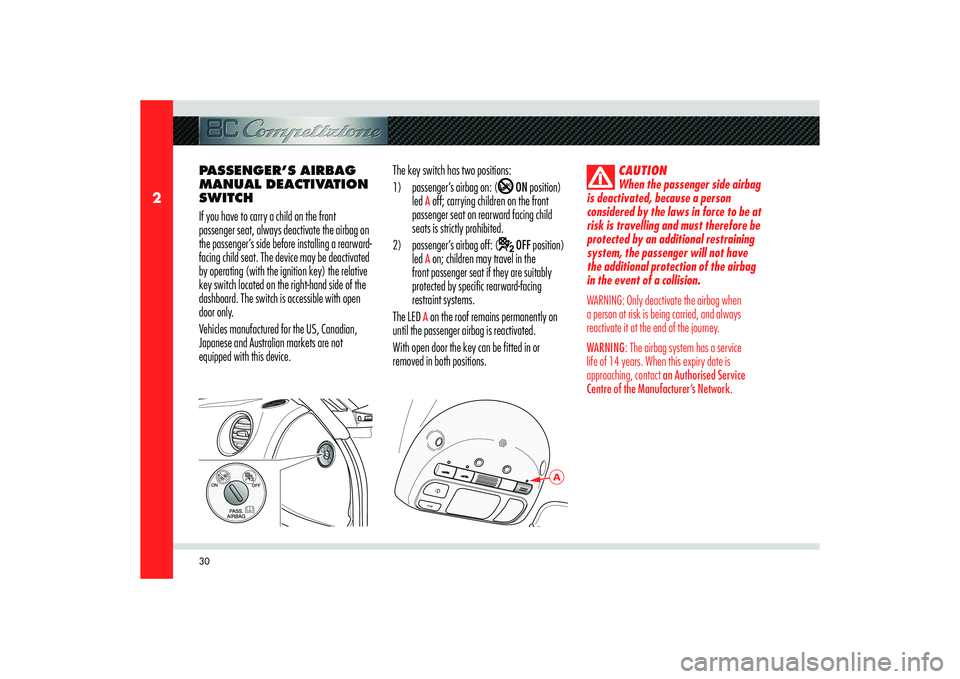
30
2
A
PASSENGER’S AIRBAG
MANUAL DEACTIVATION
SWITCH
If you have to carry a child on the front
passenger seat, always deactivate the airbag on
the passenger’s side before installing a rearward-
facing child seat. The device may be deactivated
by operating (with the ignition key) the relative
key switch located on the right-hand side of the
dashboard. The switch is accessible with open
door only.
Vehicles manufactured for the US, Canadian,
Japanese and Australian markets are not
equipped with this device.The key switch has two positions:
1) passenger’s airbag on: (
ON position)
led
A off; carrying children on the front
passenger seat on rearward facing child
seats is strictly prohibited.
2) passenger’s airbag off: (
OFF position)
led
A on; children may travel in the
front passenger seat if they are suitably
protected by specific rearward-facing
restraint systems.
The LED A on the roof remains permanently on
until the passenger airbag is reactivated.
With open door the key can be fitted in or
removed in both positions.
CAUTION
When the passenger side airbag
is deactivated, because a person
considered by the laws in force to be at
risk is travelling and must therefore be
protected by an additional restraining
system, the passenger will not have
the additional protection of the airbag
in the event of a collision.
WARNING: Only deactivate the airbag when
a person at risk is being carried, and always
reactivate it at the end of the journey.
WARNING: The airbag system has a service
life of 14 years. When this expiry date is
approaching, contact an Authorised Service
Centre of the Manufacturer’s Network.
Page 33 of 223
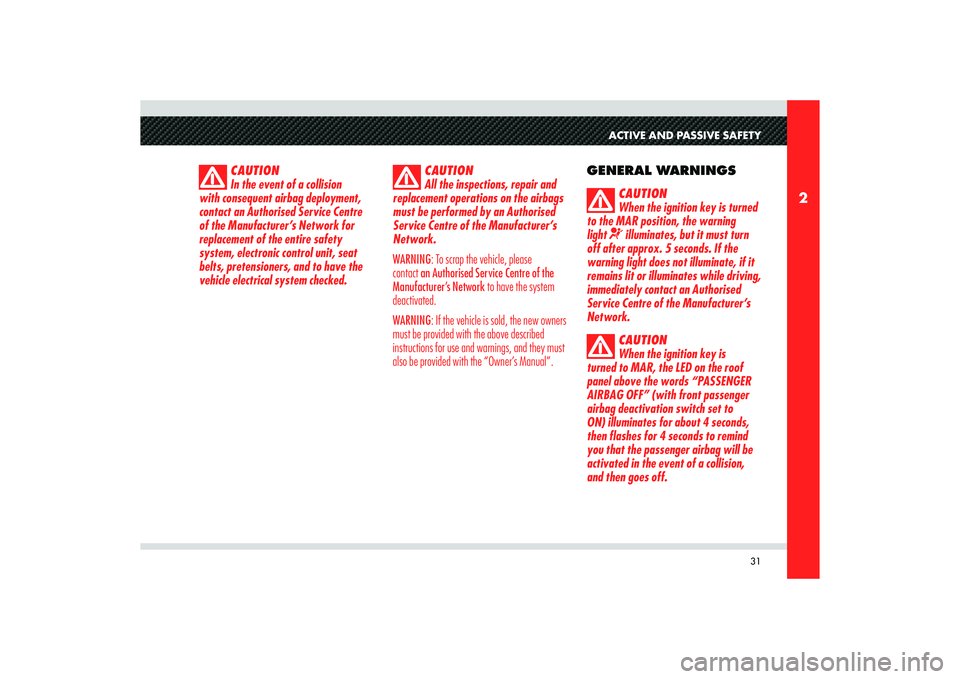
31
2
ACTIVE AND PASSIVE SAFETY
CAUTION
All the inspections, repair and
replacement operations on the airbags
must be performed by an Authorised
Service Centre of the Manufacturer’s
Network.
WARNING: To scrap the vehicle, please
contact an Authorised Service Centre of the
Manufacturer’s Network to have the system
deactivated.
WARNING: If the vehicle is sold, the new owners
must be provided with the above described
instructions for use and warnings, and they must
also be provided with the “Owner’s Manual”.
GENERAL WARNINGS
CAUTION
When the ignition key is turned
to the MAR position, the warning
light illuminates, but it must turn
off after approx. 5 seconds. If the
warning light does not illuminate, if it
remains lit or illuminates while driving,
immediately contact an Authorised
Service Centre of the Manufacturer’s
Network.
CAUTION
When the ignition key is
turned to MAR, the LED on the roof
panel above the words “PASSENGER
AIRBAG OFF” (with front passenger
airbag deactivation switch set to
ON) illuminates for about 4 seconds,
then flashes for 4 seconds to remind
you that the passenger airbag will be
activated in the event of a collision,
and then goes off.
CAUTION
In the event of a collision
with consequent airbag deployment,
contact an Authorised Service Centre
of the Manufacturer’s Network for
replacement of the entire safety
system, electronic control unit, seat
belts, pretensioners, and to have the
vehicle electrical system checked.
Page 34 of 223

32
2
CAUTION
Always drive keeping your
hands on the steering wheel so that, in
the case of activation, the airbag can
deploy without encountering obstacles
which may cause serious injuries. Do
not drive leaning forward, but keep
your seat back upright to support your
back.
CAUTION
To allow the front airbags to
deploy correctly and with optimal
efficiency, both the driver and the front
passenger must maintain a distance of
at least 25 cm from the steering wheel
and the dashboard.
CAUTION
Do not travel with objects in
your lap, in front of your chest or
holding a pipe, pencil or other object in
your mouth. In the event of a collision
with airbag deployment, these objects
may cause serious injuries.
CAUTION
Note that with the ignition
key inserted and turned to MAR,
even with the engine off, the airbags
may activate even if the vehicle is
stationary, if it is run into by another
vehicle. On the other hand, the airbags
will not activate in the event of a
collision with the vehicle stationary
and the key removed from the ignition
block: failure of the airbags to inflate
in these circumstances is not indicative
of system malfunction.CAUTION
If the vehicle has been subject
to theft or attempted theft, vandalism
or flooding, have the airbag system
checked at an Authorised Service
Centre of the Manufacturer’s Network.
CAUTION
If improper operations are
carried out on the electrical system,
the airbag could be activated, thereby
causing injuries to anyone in the
vicinity.
CAUTION
The airbags do not replace the
seat belts but provide supplementary
protection. Moreover, in the event of
head-on collisions at low speed, side
impacts, rear collisions or overturning,
the passengers are protected only by
the seat belts, which must always be
fastened.
Page 36 of 223
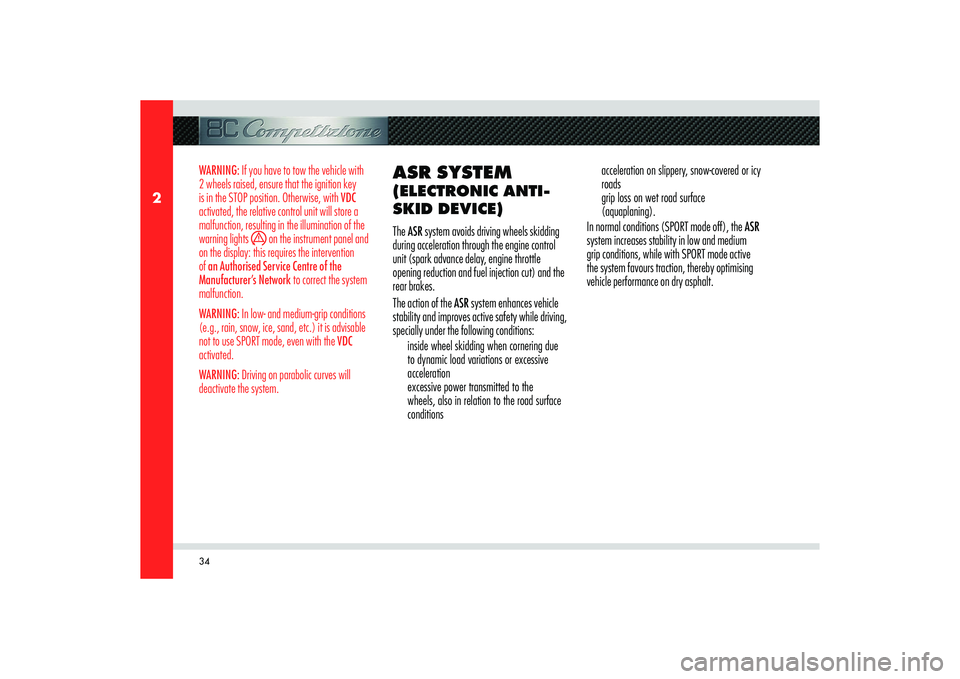
34
2
WARNING: If you have to tow the vehicle with
2 wheels raised, ensure that the ignition key
is in the STOP position. Otherwise, with VDC
activated, the relative control unit will store a
malfunction, resulting in the illumination of the
warning lights
on the instrument panel and
on the display: this requires the intervention
of an Authorised Service Centre of the
Manufacturer’s Network to correct the system
malfunction.
WARNING: In low- and medium-grip conditions
(e.g., rain, snow, ice, sand, etc.) it is advisable
not to use SPORT mode, even with the VDC
activated.
WARNING: Driving on parabolic curves will
deactivate the system.
ASR SYSTEM (ELECTRONIC ANTI-
SKID DEVICE)The ASR system avoids driving wheels skidding
during acceleration through the engine control
unit (spark advance delay, engine throttle
opening reduction and fuel injection cut) and the
rear brakes.
The action of the ASR system enhances vehicle
stability and improves active safety while driving,
specially under the following conditions:
inside wheel skidding when cornering due
to dynamic load variations or excessive
acceleration
excessive power transmitted to the
wheels, also in relation to the road surface
conditions acceleration on slippery, snow-covered or icy
roads
grip loss on wet road surface
(aquaplaning).
In normal conditions (SPORT mode off), the ASR
system increases stability in low and medium
grip conditions, while with SPORT mode active
the system favours traction, thereby optimising
vehicle performance on dry asphalt.
Page 40 of 223
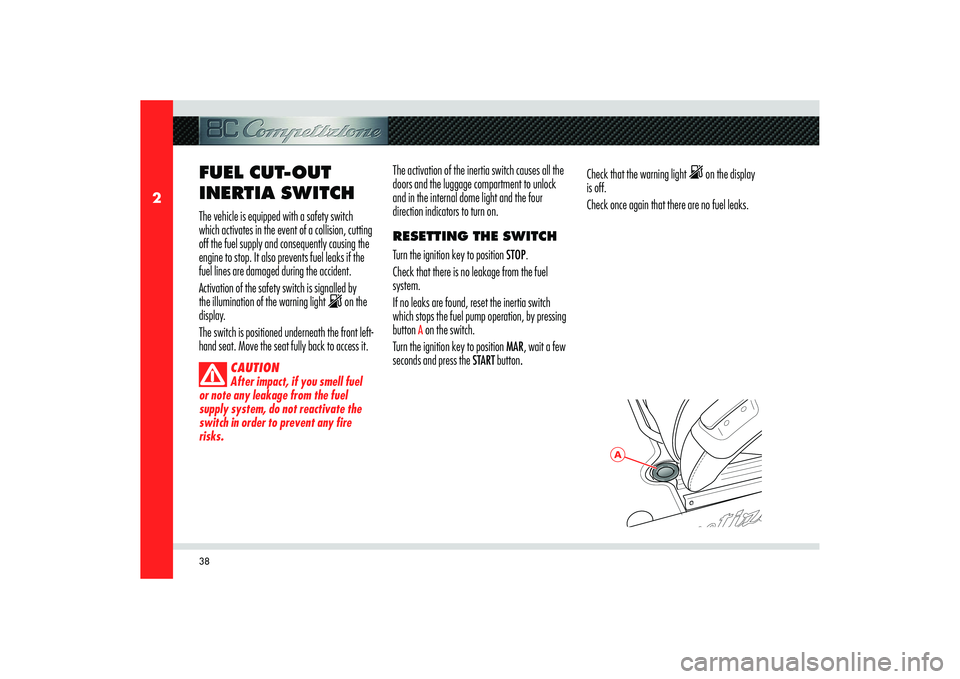
38
2
A
FUEL CUT-OUT
INERTIA SWITCHThe vehicle is equipped with a safety switch
which activates in the event of a collision, cutting
off the fuel supply and consequently causing the
engine to stop. It also prevents fuel leaks if the
fuel lines are damaged during the accident.
Activation of the safety switch is signalled by
the illumination of the warning light
on the
display.
The switch is positioned underneath the front left-
hand seat. Move the seat fully back to access it.
CAUTION
After impact, if you smell fuel
or note any leakage from the fuel
supply system, do not reactivate the
switch in order to prevent any fire
risks.
The activation of the inertia switch causes all the
doors and the luggage compartment to unlock
and in the internal dome light and the four
direction indicators to turn on.
RESETTING THE SWITCH
Turn the ignition key to position STOP.
Check that there is no leakage from the fuel
system.
If no leaks are found, reset the inertia switch
which stops the fuel pump operation, by pressing
button
A on the switch.
Turn the ignition key to position MAR, wait a few
seconds and press the START button.Check that the warning light
on the display
is off.
Check once again that there are no fuel leaks.
Page 58 of 223
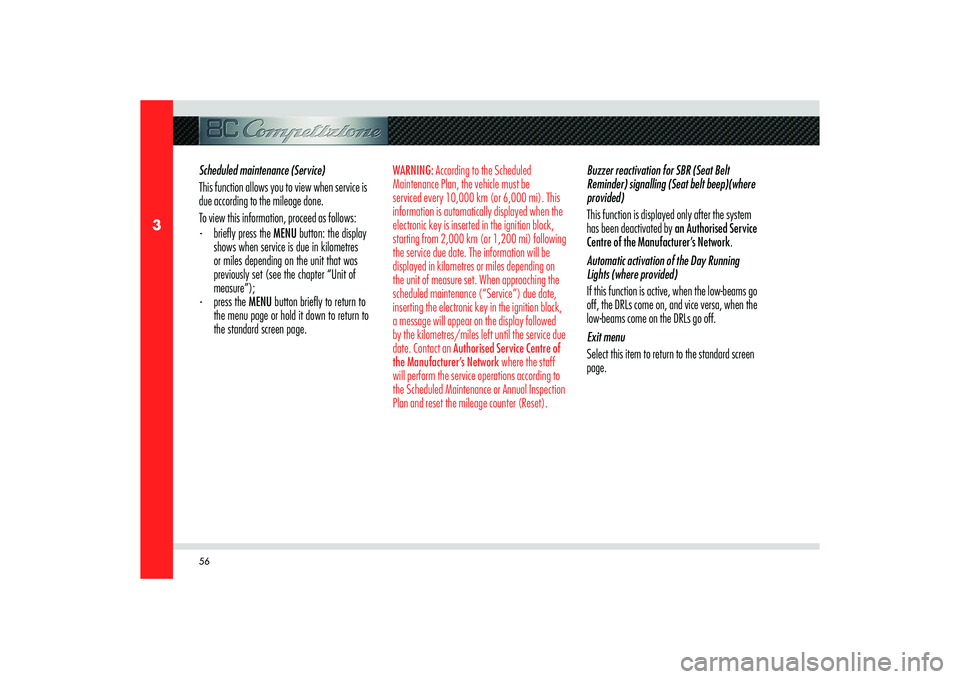
56
3
Scheduled maintenance (Service)
This function allows you to view when service is
due according to the mileage done.
To view this information, proceed as follows:
- briefl y press the MENU button: the display
shows when service is due in kilometres
or miles depending on the unit that was
previously set (see the chapter “Unit of
measure”);
- press the MENU button briefl y to return to
the menu page or hold it down to return to
the standard screen page.
WARNING: According to the Scheduled
Maintenance Plan, the vehicle must be
serviced every 10,000 km (or 6,000 mi). This
information is automatically displayed when the
electronic key is inserted in the ignition block,
starting from 2,000 km (or 1,200 mi) following
the service due date. The information will be
displayed in kilometres or miles depending on
the unit of measure set. When approaching the
scheduled maintenance (“Service”) due date,
inserting the electronic key in the ignition block,
a message will appear on the display followed
by the kilometres/miles left until the service due
date. Contact an Authorised Service Centre of
the Manufacturer’s Network where the staff
will perform the service operations according to
the Scheduled Maintenance or Annual Inspection
Plan and reset the mileage counter (Reset).
Buzzer reactivation for SBR (Seat Belt
Reminder) signalling (Seat belt beep)(where
provided)
This function is displayed only after the system
has been deactivated by an Authorised Service
Centre of the Manufacturer’s Network.
Automatic activation of the Day Running
Lights (where provided)
If this function is active, when the low-beams go
off, the DRLs come on, and vice versa, when the
low-beams come on the DRLs go off.
Exit menu
Select this item to return to the standard screen
page.
Page 59 of 223
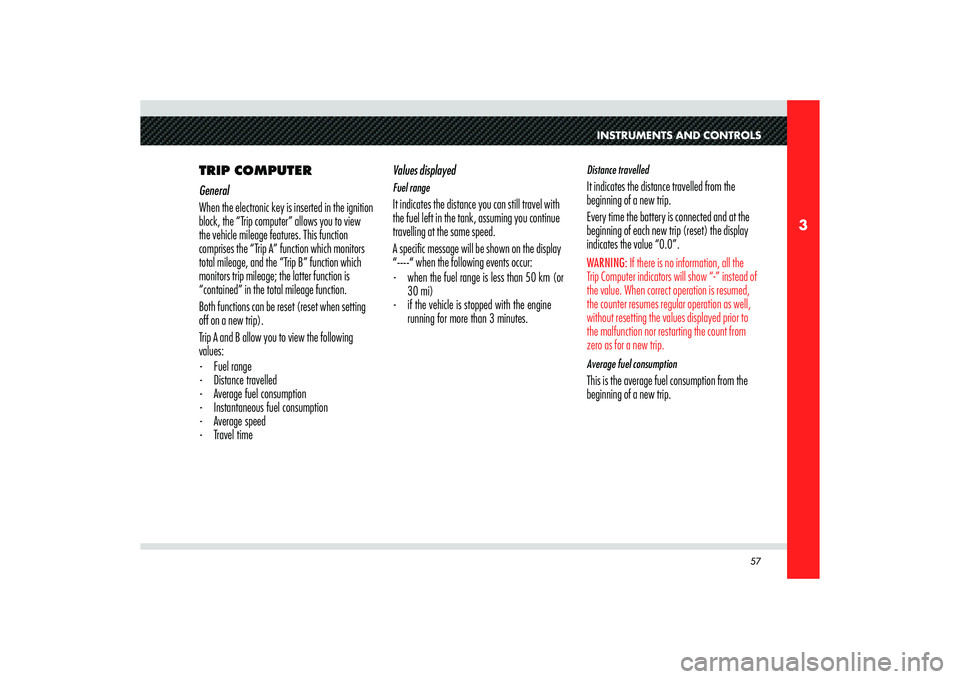
57
3
INSTRUMENTS AND CONTROLS
TRIP COMPUTER
General
When the electronic key is inserted in the ignition
block, the “Trip computer” allows you to view
the vehicle mileage features. This function
comprises the “Trip A” function which monitors
total mileage, and the “Trip B” function which
monitors trip mileage; the latter function is
“contained” in the total mileage function.
Both functions can be reset (reset when setting
off on a new trip).
Trip A and B allow you to view the following
values:
- Fuel range
- Distance travelled
- Average fuel consumption
- Instantaneous fuel consumption
- Average speed
- Travel timeValues displayed
Fuel rangeIt indicates the distance you can still travel with
the fuel left in the tank, assuming you continue
travelling at the same speed.
A specific message will be shown on the display
“----“ when the following events occur:
- when the fuel range is less than 50 km (or
30 mi)
- if the vehicle is stopped with the engine
running for more than 3 minutes.
Distance travelledIt indicates the distance travelled from the
beginning of a new trip.
Every time the battery is connected and at the
beginning of each new trip (reset) the display
indicates the value “0.0”.WARNING: If there is no information, all the
Trip Computer indicators will show “-” instead of
the value. When correct operation is resumed,
the counter resumes regular operation as well,
without resetting the values displayed prior to
the malfunction nor restarting the count from
zero as for a new trip.Average fuel consumptionThis is the average fuel consumption from the
beginning of a new trip.